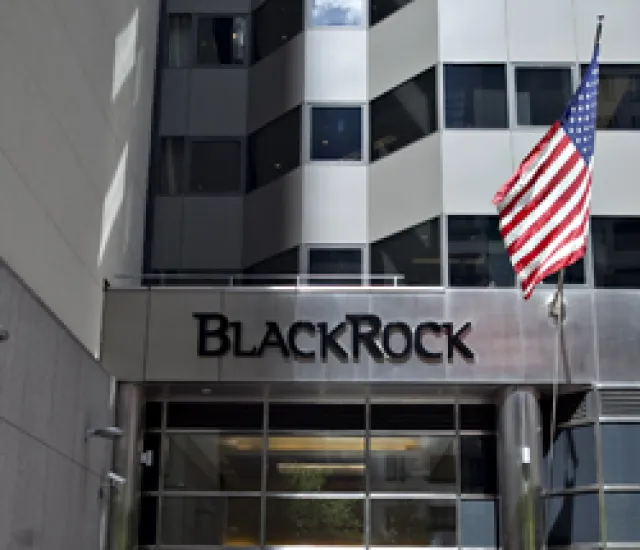T. Rowe Price Associates is the quintessential American money manager. Its glass-clad building, an anchor of Baltimore’s Inner Harbor, is just a short trip from Fort McHenry, where 1,000 Americans staved off the British during the Battle of Baltimore and inspired Francis Scott Key to write the “Star-Spangled Banner.”
T. Rowe Price Associates’ business mix and growth prospects are also quintessentially American. About a decade ago it didn’t source one client from outside the U.S. Now 12 percent of its assets are international. Kenneth Moreland, chief financial officer of T. Rowe Price, says the money manager has been growing globally at about 1 percent each year for the past ten years.
“International is a ‘creeps-up-on-you’ kind of story here,” Moreland explains.
The international story at T. Rowe is still nascent. With $482 billion in assets, T. Rowe is the 19th-largest firm in this year’s II300, Institutional Investor’s annual ranking of the 300 biggest U.S. money managers. But just $89.7 billion, or 18.6 percent, of those assets are invested outside the U.S. Moreland insists that the firm has been cautious in its global expansion, planting roots locally and sticking to its investment strategy of doing fundamental research. About 30 percent of the firm’s nearly 400 investment professionals are focused outside the U.S. During the past decade, T. Rowe has grown its product line for non-U.S. investors, which now includes both global equity, ranging from large-cap to emerging-markets, and fixed income. The firm has gained brand recognition through strong investment performance.
Like all of the U.S.’s largest money managers, T. Rowe is facing unprecedented competition in its home market. The money management industry has been wracked by the financial crisis, scandals, a bear market, and investor skepticism and risk aversion. Though asset flows into U.S. domestic equity funds have again become positive, they are far from the highs achieved before the crisis that fueled decades of easy growth for the industry. Winners in the U.S. market the past few years have been those with a flush lineup of lower-margin, conservative bond funds.
But for managers going outside the U.S., life is bullish. Similarly to U.S. industrial and technology giants, money managers are fueling their growth from abroad. Some — such as New York–based PineBridge Investments (No. 61, with $82.1 billion in assets), the former investment arm of American International Group — are directing their retail expansion efforts outside the U.S. altogether. PineBridge has 51.2 percent of its assets invested outside the U.S.
Some of the largest money managers on the II300 are also significant managers of non-U.S. securities. New York–based BlackRock, which towers over the II300, with $3.6 trillion in assets, has 42 percent of its money invested outside the U.S. Los Angeles’s Capital Group Cos., sponsor of the ubiquitous American Funds family and No. 7, with $1.2 trillion, has 38.1 percent of its assets outside the U.S. San Mateo, California–based Franklin Templeton Investments, No. 11, with $670.7 billion, has 55.3 percent of its assets in non-U.S. markets. Other U.S. giants have a much smaller percentage of international assets and may find growth slowing. Boston’s Fidelity Investments, No. 3, with $1.5 trillion, has only 22.3 percent invested outside the U.S.; No. 4–ranked Vanguard Group of Malvern, Pennsylvania, has 19.7 percent of its $1.4 trillion overseas.
New York’s J.P. Morgan Asset Management, No. 6, with $1.3 trillion in assets, is looking to increase the global revenue for its institutional business. The firm now derives about 60 percent of its institutional revenue from the U.S. In the past year it has hired eight senior client advisory and distribution managers to expand its international effort, including one to focus exclusively on sovereign wealth funds. J.P. Morgan would like to achieve a 50-50 split between U.S. and international revenue within three years.
“Over half the world’s pension assets are outside the U.S.,” points out Michael O’Brien, global head of the institutional client group, who will temporarily relocate to New York from London this summer. “Over half of insurance assets are outside the U.S. Sovereign wealth funds are almost exclusively outside the U.S., so you have to build a global franchise.”
Investors are demanding more specialized global investment strategies, not unlike the breakdown of the U.S. domestic equity market into nine style boxes. Managers can no longer simply offer a global equity product. J.P. Morgan’s O’Brien says that investors are not just adding emerging-markets debt but thinking about whether it’s from Latin America or a particular region of Asia. They are also asking whether they should invest in emerging markets through major countries like Brazil, Russia, India and China or pursue a broader approach. For China do investors go through private or public markets? O’Brien says J.P. Morgan’s international road shows for pension fund managers have been packed as investors seek on-the-ground information to explore new opportunities.
Some money managers are carefully picking their global spots in which to invest. Locating analysts and portfolio managers outside the U.S. is expensive, particularly if new offices have to be opened. Though fees are higher for mandates managed globally, operational and other expenses make the margins similar to those of domestic strategies with their lower fees and lower costs. Michael Jones, president of Columbia Management Investment Advisers in Boston, says his firm is targeting the Middle East, Asia ex-Japan, Australia, Canada, and the Nordic and Benelux regions of Europe. Parent Ameriprise Financial in Minneapolis purchased Columbia from Bank of America in April 2010 and has combined the firm with its RiverSource Investments asset management arm. The purchase pushed Ameriprise from No. 28 to No. 21 this year, with $456.9 million in assets. Jones says the scale that the firm now has allows it to put resources behind global expansion and product development.
One of the keys to going global is figuring out how to crack China and profit from its appealing demographics. Atlanta-based Invesco — which moves up three spots to No. 15, with $616.5 billion in assets after its June 2010 acquisition of Morgan Stanley’s retail businesses, including Van Kampen Investments — has had a presence in China since 2003 through a Shenzhen-based joint venture called Invesco Great Wall Fund Management Co. (Huaneng Capital Services is the parent company of Great Wall Securities, Invesco’s Chinese partner.) With a staff of more than 110, Great Wall manages $7.6 billion in mutual funds for the domestic Chinese market. Loren Starr, Invesco’s CFO, says the fund company is looking forward to selling the Chinese on such new products as exchange-traded funds. “It’s a changing environment in China as investors are increasingly open to products that aren’t exclusively focused on Chinese equities or securities,” explains Starr, whose firm has $60 billion in ETFs.
The global opportunity set is especially attractive given that the economic recovery in the U.S. appears to have stalled and markets in the developing world have shown remarkable resilience in the aftermath of the financial crisis. India, for example, is in need of massive amounts of new infrastructure, and people in China and Africa are still in the early stages of loading up on mobile phones, automobiles and televisions. As the U.S. population is aging and still dealing with a prolonged housing downturn that has destroyed the biggest portion of Americans’ net worth, people in the developing world are coming of age, forming households, buying homes, joining the middle class and learning to invest. On the institutional side sovereign wealth funds and non-U.S. pension funds are diversifying into less-conservative assets and are vying for services from the elder statesmen of the asset management industry — large U.S. investment firms — to manage their portfolios.







